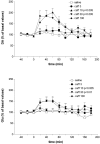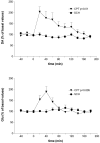Caffeine induces dopamine and glutamate release in the shell of the nucleus accumbens
- PMID: 12151508
- PMCID: PMC6758129
- DOI: 10.1523/JNEUROSCI.22-15-06321.2002
Caffeine induces dopamine and glutamate release in the shell of the nucleus accumbens
Abstract
An increase in the extracellular concentration of dopamine in the nucleus accumbens (NAc) is believed to be one of the main mechanisms involved in the rewarding and motor-activating properties of psychostimulants such as amphetamines and cocaine. Using in vivo microdialysis in freely moving rats, we demonstrate that systemic administration of behaviorally relevant doses of caffeine can preferentially increase extracellular levels of dopamine and glutamate in the shell of the NAc. These effects could be reproduced by the administration of a selective adenosine A1 receptor antagonist but not by a selective adenosine A2A receptor antagonist. This suggests that caffeine, because of its ability to block adenosine A1 receptors, shares neurochemical properties with other psychostimulants, which could contribute to the widespread consumption of caffeine-containing beverages.
Figures




References
-
- Boye SM, Grant RJ, Clarke PB. Disruption of dopaminergic neurotransmission in nucleus accumbens core inhibits the locomotor stimulant effects of nicotine and d-amphetamine in rats. Neuropharmacology. 2001;40:792–805. - PubMed
-
- Chen J, Paredes W, Lowinson JH, Gardner EL. Strain-specific facilitation of dopamine efflux by δ9-tetrahydrocannabinol in the nucleus accumbens of rat: an in vivo microdialysis study. Neurosci Lett. 1991;129:136–140. - PubMed
-
- Daly JW, Fredholm BB. An atypical drug of dependence. Drug Alcohol Depend. 1998;51:199–206. - PubMed
-
- Ferré S, Fredholm BB, Morelli M, Popoli P, Fuxe K. Adenosine-dopamine receptor-receptor interactions as an integrative mechanism in the basal ganglia. Trends Neurosci. 1997;20:482–487. - PubMed
Publication types
MeSH terms
Substances
LinkOut - more resources
Full Text Sources
Other Literature Sources
Medical
